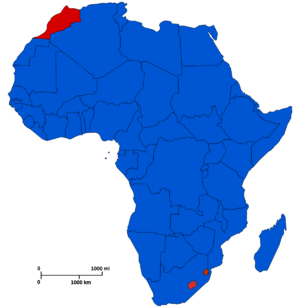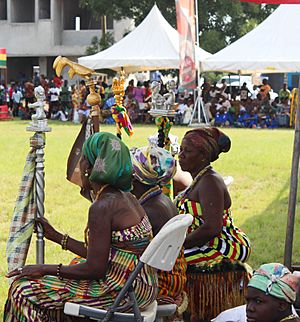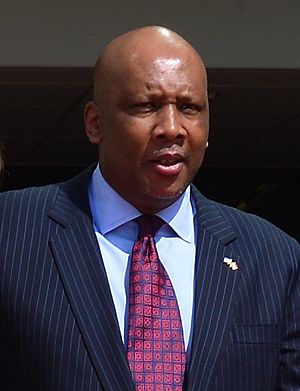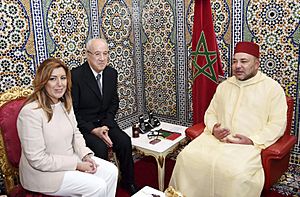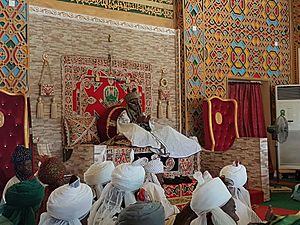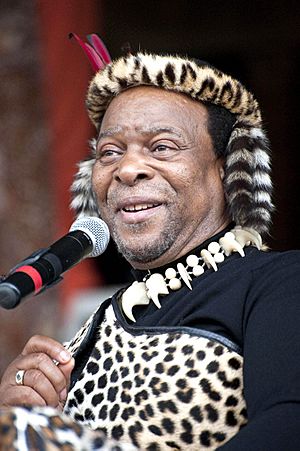Monarchies in Africa facts for kids
Africa has several monarchies. These are countries or areas where a single person, like a king or queen, holds the highest power as the head of state. This leader usually inherits their position and stays in power for life.
Today, only three African countries are sovereign monarchies. This means they are fully independent and have a king or queen as their head of state. Two of these, Lesotho and Morocco, are constitutional monarchies. This means the king or queen must follow laws and customs. The third, Eswatini, is an absolute monarchy. Here, the king rules with almost no limits.
Besides these, there are also "sub-national" monarchies. These are kings or queens who rule smaller areas within a larger country. They are not independent states. Africa also has three areas that are dependencies of European monarchies.
Contents
African Monarchies: A Look Back in Time
Long ago, people in West and North Africa started forming states. This happened because they could trade across the Sahara Desert. This trade helped them build formal towns and cities. Strong leaders were needed to manage these new places.
This is how kingdoms like the Mali Empire started in the 1200s. A famous leader named Sundiata Keita helped create it. Other kingdoms like Takrur in Senegal and Kanem near Lake Chad also grew.
Some monarchies in Africa grew on their own. Others were formed with help from outside. For example, Rome helped create the Kingdom of Numidia in North Africa around 200 BC. Its first king was Masinissa. He united many local groups and became their king with Rome's support.
To show their power, kings and queens often used special rituals and symbols. They wanted people to see them as special, almost like a link between the gods and the people. This made people believe their leaders were fair and looked out for everyone.
Monarchs also showed their power with special clothes, crowns, jewelry, and weapons. They had unique thrones, like golden stools. Some even built shrines for their ancestors, like the Lozi people in Zambia.
Kings and Queens in Africa Today
Independent Monarchies in Africa
| State | Type of Monarchy | How the Leader is Chosen | Ruling Family | Title | Image | Current Leader | Born | Age | Started Reigning | Next in Line |
|---|---|---|---|---|---|---|---|---|---|---|
| Constitutional | Inherited | Alaouite | King | 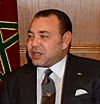 |
Mohammed VI | 21 August 1963 | 62 y. | 23 July 1999 | Crown Prince Moulay Hassan, Crown Prince of Morocco (his only son) | |
| Absolute | Inherited and chosen | Dlamini | King | 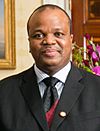 |
Mswati III | 19 April 1968 | 57 y. | 25 April 1986 | None; the king does not name his successor. | |
| Constitutional | Inherited and chosen | Moshesh | King |  |
Letsie III | 17 July 1963 | 62 y. | 7 February 1996 | Crown Prince Prince Lerotholi Seeiso (his only son) |
Lesotho: A Mountain Kingdom
Lesotho is a small country completely surrounded by South Africa. It is a constitutional monarchy, meaning its king follows a constitution. The monarchy began in 1824 when a tribal chief named Moshoeshoe I united different tribes. He formed the Basotho kingdom.
After Moshoeshoe I died, the British took some control. But the local tribes fought back. Full British control was set up in 1884, calling the area Basutoland. Even under British rule, the monarchy continued with some power, especially in rural areas.
Lesotho became fully independent in 1966. A constitutional monarchy was set up. However, the elected government was later overthrown. The monarchy lost some power until democracy returned in 1993. The current king, Letsie III, became king in 1996.
Under Lesotho's constitution, the King is the head of state. But the Parliament holds the real power. The King is usually chosen by family tradition. However, a group of chiefs officially appoints him using old customs. The Prime Minister can even remove the king if he breaks his oath or is unfit to rule.
Morocco: A Kingdom by the Sea
Morocco is in the northwest corner of Africa. It has a very long history. It was once controlled by Carthage, then the Roman Empire, and later by Arab rulers. During this time, people from Morocco were known as Moors.
After 1492, Morocco faced a tough period. In 1912, it came under French and Spanish control. Morocco gained independence in 1956. Sultan Mohammed ben Youssef became King Mohammed V. The current king, Mohammed VI, became king in 1999.
Morocco's constitution, updated in 2011, says it is a constitutional monarchy. However, the King still has a lot of power. He leads important religious councils. He also chairs the Supreme Court and is an active part of the government. He can even dismiss ministers and set the government's plans. The King also leads the Security Council, which oversees the military.
Eswatini: An Absolute Monarchy
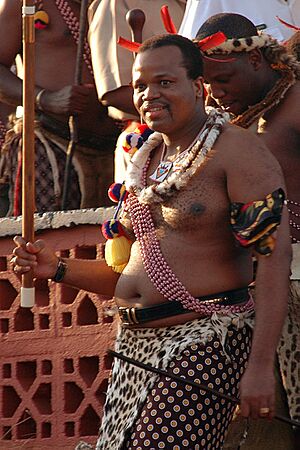
Eswatini, in southeastern Africa, started as a group of African tribes. This happened about 75 years before Lesotho, in the mid-1700s. Chief Ngwane III of the Swazi people moved his tribe and united with others.
In the 1830s, British traders and Dutch settlers (called Boers) came to Eswatini. The Swazi people, who couldn't read or write, were tricked into signing treaties. These treaties gave their land to the Boer Republics. The British took control in 1902 after the Boer War.
Eswatini regained control of its own affairs in 1967 and became independent the next year. King Sobhuza II ruled for most of the colonial period and after independence. In 1973, he ended the democratic constitution and declared himself an absolute ruler. He reigned for 82 years, one of the longest reigns ever!
The current ruler, King Mswati III, became king in 1986. A new constitution in 1998 allowed for some democracy. But in reality, Eswatini is still an absolute monarchy. Citizens have limited power in how the country is run.
Areas Connected to Other Monarchies
Canary Islands: Spanish Islands in Africa
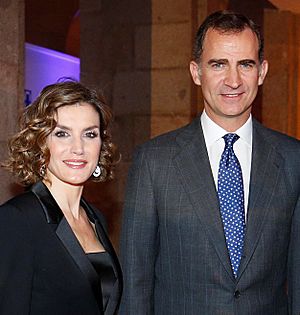
The Canary Islands are a group of 13 islands off the coast of Morocco. They were first home to the Guanche people. Spain took control of them in the late 1400s. The islands were important for Spanish trade and were often attacked by pirates. The islands gained some self-rule in 1982.
As a self-governing part of Spain, the Canary Islands have a lot of freedom. They have their own parliament and president. They manage their natural resources and tourism. They also share power with Spain's central government on things like farming and trade. Each island also has its own local government.
Ceuta and Melilla: Spanish Cities in Africa
Ceuta and Melilla are two cities on the northwest coast of Africa, next to Morocco. They were founded by the Carthaginians. Later, they were ruled by Romans, Vandals, and Byzantines before Arabs took them over in the 700s. Ceuta was a key base for the Moorish conquest of Spain.
Portugal conquered Ceuta in 1415, and Spain took Melilla in 1497. When Spain and Portugal united in 1580, Ceuta also came under Spanish control. It has been Spanish ever since. Both cities gained more land during the Spanish-Moroccan War. They were granted self-rule in 1995. Morocco still claims these cities, which causes some tension.
Both cities have their own parliaments and a mayor-council system. They have a lot of freedom to manage their own affairs. They can also collect taxes to pay for city services like the police.
Saint Helena, Ascension and Tristan da Cunha: British Islands
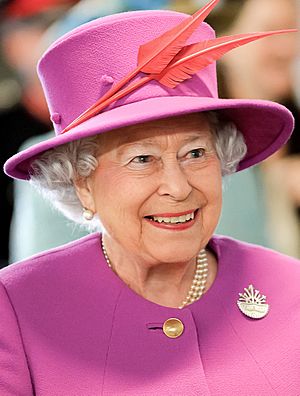
Saint Helena, Ascension and Tristan da Cunha is a British Overseas Territory in the Atlantic Ocean. It is ruled by Queen Elizabeth II, who is also Queen of Saint Helena. A governor represents her locally.
Portuguese explorers first found Saint Helena in the early 1600s. They used it as a stopover but didn't settle there permanently. The British East India Company later governed the island for about 200 years. In the early 1800s, the British government took direct control.
Ascension Island was added to the territory in the 1920s, and Tristan da Cunha was added in the 1930s.
Local Monarchies Within Countries
Many African countries still have local kings or chiefs. These leaders have traditional authority based on old customs. Some of them are even recognized by the country's constitution or laws. Examples include the Nigerian traditional rulers and the Zulu King in South Africa. They lead smaller communities within the larger country.
Monarchies That No Longer Exist
African Empires of the Past
- Ancient empires in North Africa during the Iron Age.
- The Ancient Egyptian civilization.
- Islamic empires (called caliphates) in North Africa from the 700s to the 1200s.
- The medieval Sahelian kingdoms in West Africa.
- The Ethiopian Empire was special. It existed continuously from the 1200s to the 1900s. It was never fully conquered by Islamic groups or European colonizers.
- Empires from the 1400s to 1800s:
- Islamic sultanates in Sudan and the great Somali Empire.
- New kingdoms in West Africa after the Sahelian kingdoms.
- Kingdoms in Central and Southern Africa, like the Kongo Kingdom and the Mutapa Empire.
- The Merina Kingdom of Madagascar.
Monarchies That Ended in the 1900s
 Ankole (Uganda) (ended 1967)
Ankole (Uganda) (ended 1967) Burundi (ended 1966)
Burundi (ended 1966) Central African Empire (ended 1979)
Central African Empire (ended 1979) Congo Free State (taken over by Belgium 1908)
Congo Free State (taken over by Belgium 1908) Egypt Kingdom of Egypt (ended 1953)
Egypt Kingdom of Egypt (ended 1953) Ethiopia Ethiopian Empire (ended 1975)
Ethiopia Ethiopian Empire (ended 1975) Libya Kingdom of Libya (ended 1969)
Libya Kingdom of Libya (ended 1969) Rwanda Kingdom of Rwanda (ended 1961)
Rwanda Kingdom of Rwanda (ended 1961) Tunisia Kingdom of Tunisia (ended 1957)
Tunisia Kingdom of Tunisia (ended 1957) Zanzibar (ended 1964)
Zanzibar (ended 1964)
Former Commonwealth Realms
These countries once had the British monarch (like Queen Elizabeth II) as their head of state. They later became republics with their own presidents.
| Country | British Head of State | Local Representative | When it Ended |
|---|---|---|---|
| Elizabeth II | Governor-General Sir Farimang Mamadi Singateh | 1970 | |
| Governor-General The Earl of Listowel | 1960 | ||
| Governor-General Malcolm MacDonald | 1964 | ||
| Governor-General Sir Glyn Smallwood Jones | 1966 | ||
| Governor-General Sir Veerasamy Ringadoo | 1992 | ||
| Governor-General Nnamdi Azikiwe | 1963 | ||
| Officer Administering the Government Clifford Dupont | 1970 (not recognized by UK) | ||
| Governor-General Christopher Okoro Cole | 1971 | ||
| Governor-General Charles Robberts Swart | 1961 | ||
| Governor-General Sir Richard Turnbull | 1962 | ||
| Governor-General Sir Walter Coutts | 1963 |
Images for kids
-
King Mswati III of Eswatini


